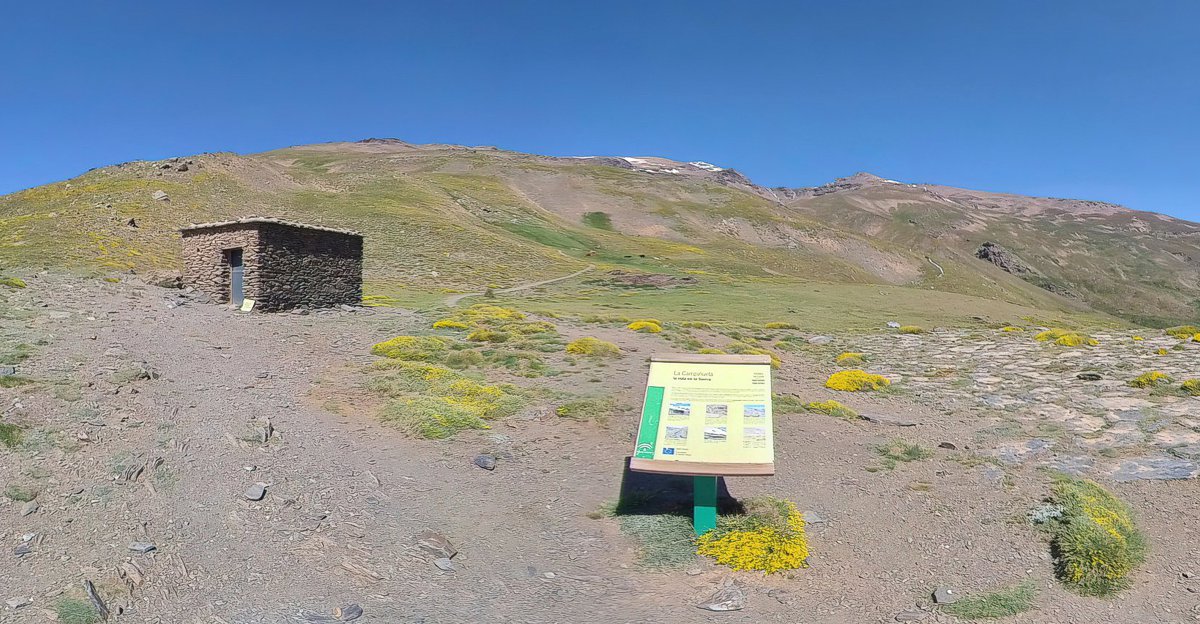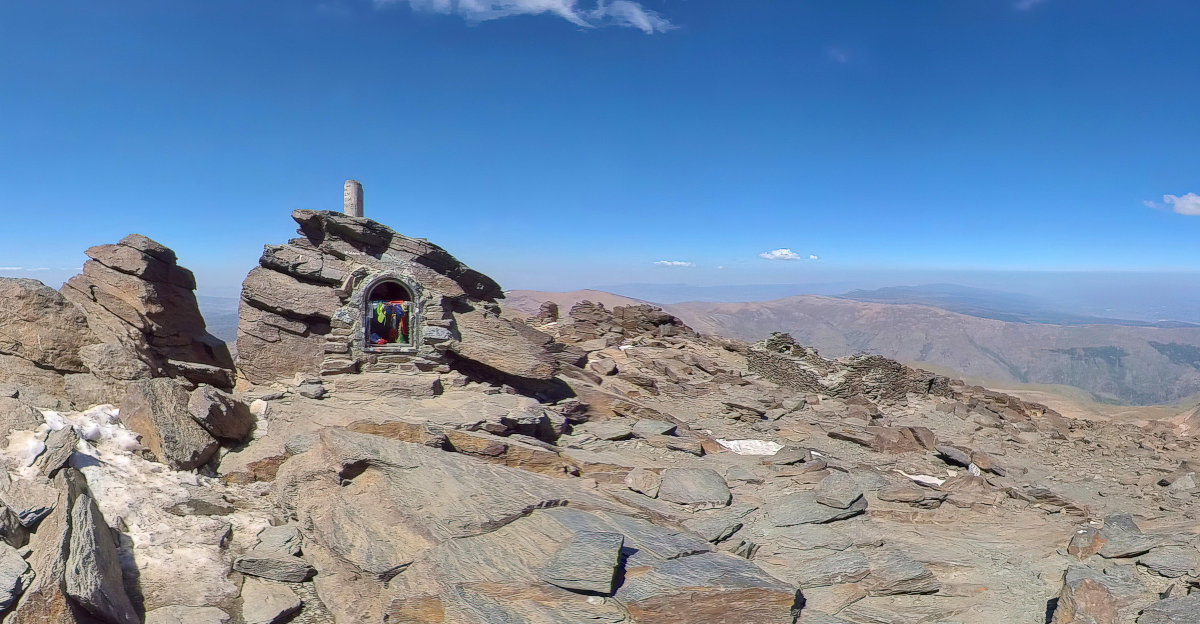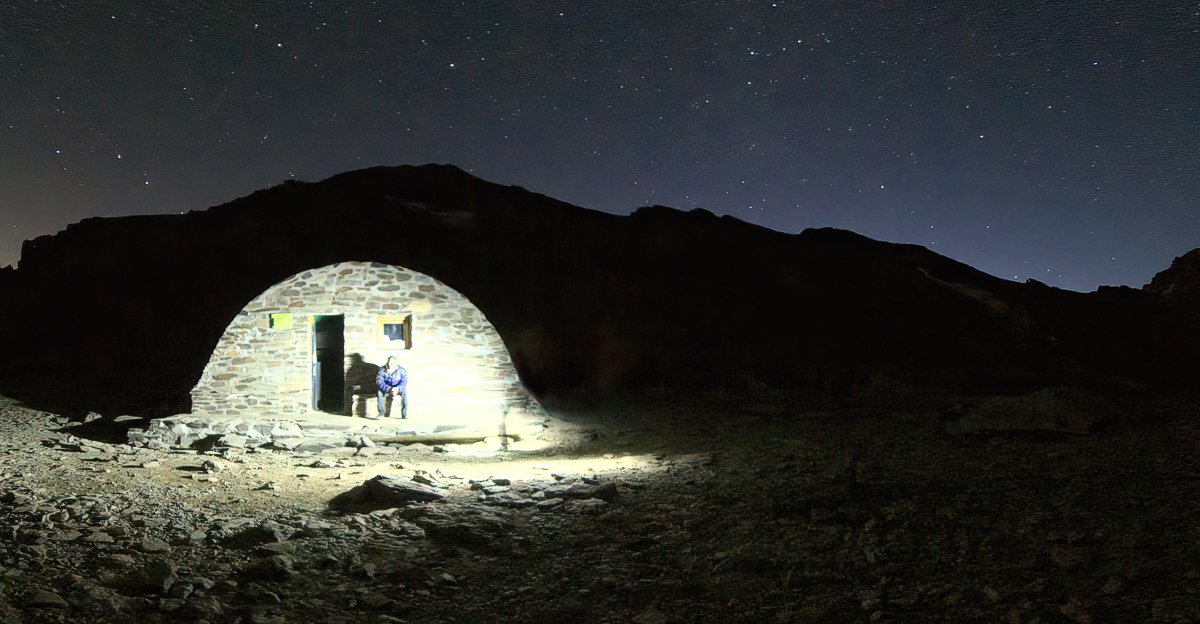The route of the Virtual Tour starts outside Hotel La Fragua I, where I stayed in Travélez the night before the grand expedition. It follows a well-marked trail, the PR-A-27 “Sendero Travélez – Siete Lagunas” which as its name suggest and the information board at the trail head tells you, takes you from Travélez at around 1400m to the Siete Lagunas (Seven Lakes), one of the most beautiful high mountain landscapes in all of the Sierra Nevada. After following the first section of the trail on the Piedra Roja path to Piedra Redonda, a steep ascent takes one to the Acequia Gorda which is followed and crossed before reaching the area known as Campiñuela at around 2400m and the modest emergency Refugio vivac La Campiñuela.

|
|
Refugio vivac La Campiñuela, Sierra Nevada, Spain.
|
From Refugio vivac La Campiñuela it was a pleasant walk to the Culo Perro river where the regular fording point of the PR-A-27 was made impossible by waters running deep with the melting snow still lingering in patches high above. After locating an alternative crossing point, and climbing alongside the waterfall of the Chorreras Negras (Black Rocks), I finally arrived at the Siete Lagunas, or rather the lower and largeest of the seven lakes, Laguna Hondera. This was unlike any of the photos I had seen, overflowing with melt water and filling the valley as a broad river rather than the timid lagoon often pictured. I found a large flattish boulder and basked in the sun, ate lunch and observed if I would have time to detour to La Alcazaba (The Castle), a 3369m peak off to the north and of significant repute. Alas I did not. The route of a direct ascent from La Alcazaba to Mulhacén is unclear and described as a challenging scramble. Thus it was potentially unsuitable for someone burdened with a 14Kg backpack, and I would be retracing my steps to my boulder. No, it would make more sense to push on to my primary target, Mulhacén I. On route I would take in Mulhacén II, at 3362m included in lists of the ‘Los Tres Miles’, though for what reason I could not say, there appeared to be no significant elevation, and many more rocky outcrops that did. However it was and is clearly marked by a concrete triangulation pillar and no great hardship to reach. And indeed from Mulhacén II it is an easy path up to the nation’s high point and its cluster of ruins, shrine, cairn, and triangulation pillar.

|
|
The summit of Mulhacén, Sierra Nevada, highest mountain in European Spain.
|
I spent some time at the summit, appreciating the views that had been obscured by cloud on my previous visit, and chatting to a friendly young man originally from Palestine but now living in Hungary. Then for the rapid descent to the Refugio at Laguna de la Caldera where I tried and failed to muster the motivation to climb the one hundred and sixty metres to Puntal de la Caldera (3222m). Instead I spent the evening preparing dinner and conversing with Federico, a Spanish hiker of similar years as myself.
The Saharan sand that had turned Spain’s sky an otherworldly orange a few months earlier, blotting out the sun, and coating every surface in a grimy clay was a reoccurring theme of our conversations. The Spanish have a special name for the phenomenon, they call it the “calima”. Federico liked to add a rather Anglo-Saxon prefix when he spoke about it and for very good reason. Even up here we had not escaped its effects. Nearly every rock was covered, and more importantly the sand had settled into our water supply, the Laguna de la Caldera. Drinking the orange water was the only option if we were to stay hydrated.
We spoke about wildlife and photography too. Venturing from the refugio at 3:30 am to take panoramas of the night sky, playing with exposures to capture the stars without motion trails, a feel for the mountains, and the hut itself. 20 seconds at ISO400 seemed to provide the best result before the cold and battery failure drove us back inside to the sleeping bags.

|
|
Refugio Vivac de la Caldera, Sierra Nevada, Spain.
|
Refugio Vivac de la Caldera is an unguarded stone built bothy, clean, tidy, and furnished with two sleeping platforms, one above the other, sufficient for fourteen. There is also a wooden topped stone table and pair of benches for meals. And it was on this that I made hot chocolate for breakfast as the sun rose on day two.






